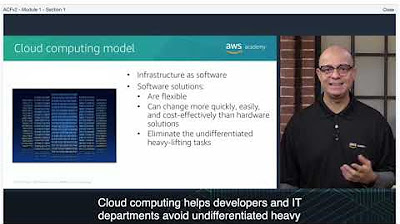Apa itu Cloud Computing?
Summary
TLDRThe script introduces cloud computing as a metaphorical 'ocean' of computing power accessible via the internet. It explains how cloud services like Gmail, Google Drive, and social media platforms enable users to access and manage data from anywhere with an internet connection. The video outlines three main types of cloud computing: Software as a Service (SaaS), Platform as a Service (PaaS), and Infrastructure as a Service (IaaS), highlighting their benefits such as cost savings, flexibility, and efficiency. It concludes by emphasizing the importance of learning cloud computing for its wide-ranging applications in business, finance, and IoT.
Takeaways
- 🌐 Cloud computing is a term that literally means 'computing in the cloud,' which refers to processing computational power through the internet.
- 💻 The script uses the example of checking emails on Gmail from different locations to illustrate the convenience of cloud computing.
- 📱 Mobile devices and internet connectivity are all that's needed to access cloud services, as demonstrated with the Gmail example.
- 📚 There are various examples of cloud computing services, including Google Drive, and social media platforms like Facebook, Twitter, and Instagram.
- 🛠️ The script explains three types of cloud computing: Software as a Service (SaaS), Platform as a Service (PaaS), and Infrastructure as a Service (IaaS).
- 📧 SaaS allows direct use of provided applications, with email services like Gmail, Yahoo, and Outlook being common examples.
- 🔧 PaaS provides a computing platform with systems like web servers and application frameworks to run custom applications.
- 🏢 IaaS offers infrastructure components such as servers, RAM, storage, and network configurations to build virtual machines.
- 🌟 Providers for PaaS and IaaS services include Google Cloud Platform, Amazon Web Services, and Microsoft Azure.
- 💰 The benefits of cloud computing include cost savings, as businesses only need to pay for subscriptions without investing in hardware.
- 🔄 Flexibility is enhanced as cloud computing allows for easier document and data access, regardless of time and location, with an internet connection.
- 👥 Efficiency and collaboration are improved, as employees can work on data simultaneously with quick and secure document transfers.
Q & A
What is the literal meaning of 'cloud computing'?
-The term 'cloud computing' is a combination of 'cloud,' which is a metaphor for the internet, and 'computing,' which refers to computers. So, 'cloud computing' literally means processing computational power through the internet.
How does cloud computing enable users to access their emails from different locations?
-Cloud computing allows users to access their emails from different locations by using email services like Gmail, which can be checked using a smartphone and an internet connection, regardless of the user's physical location.
What are some examples of cloud computing services mentioned in the script?
-Some examples of cloud computing services mentioned in the script are Gmail for email, Google Drive for online storage, and social media platforms like Facebook, Twitter, and Instagram.
What are the three types of cloud computing services described in the script?
-The three types of cloud computing services described are: 1) Software as a Service (SaaS), which provides applications over the internet; 2) Platform as a Service (PaaS), which offers a platform for developers to build applications; and 3) Infrastructure as a Service (IaaS), which provides virtualized computing resources over the internet.
Which companies are mentioned as providers of cloud computing services?
-The companies mentioned as providers of cloud computing services are Google Cloud Platform, Amazon Web Services, and Windows Azure.
How does cloud computing save costs for businesses?
-Cloud computing saves costs for businesses by eliminating the need for significant upfront investment in hardware and software. Instead, businesses pay for the services they use, which can be scaled up or down as needed.
What is the benefit of cloud computing in terms of flexibility?
-Cloud computing offers flexibility by allowing users to access and interact with data from anywhere and at any time, as long as they have an internet connection, without being limited by physical location or time.
How does cloud computing improve efficiency and effectiveness in the workplace?
-Cloud computing improves efficiency and effectiveness by enabling employees to share and work on data simultaneously. All documents can be transferred quickly and securely, facilitating collaborative work.
What are some fields where cloud computing is beneficial as mentioned in the script?
-Cloud computing is beneficial in various fields such as business, banking, finance, internet of things, and other areas that can simplify many human tasks.
Why is it recommended to learn about cloud computing according to the script?
-It is recommended to learn about cloud computing because it has many benefits and is an integral part of current technological advancements, especially in the fields of business, finance, and other areas where it can streamline processes and improve efficiency.
Outlines

This section is available to paid users only. Please upgrade to access this part.
Upgrade NowMindmap

This section is available to paid users only. Please upgrade to access this part.
Upgrade NowKeywords

This section is available to paid users only. Please upgrade to access this part.
Upgrade NowHighlights

This section is available to paid users only. Please upgrade to access this part.
Upgrade NowTranscripts

This section is available to paid users only. Please upgrade to access this part.
Upgrade Now5.0 / 5 (0 votes)





